Overview
The article delineates ten essential items that must be incorporated into a Google Ads optimization checklist to significantly enhance ad performance and achieve superior ROI. It underscores strategies such as:
- Adjusting bids
- Targeting the right audience
- Crafting compelling ad copy
- Utilizing ad extensions
These strategies are bolstered by expert insights and case studies that vividly demonstrate their effectiveness in improving engagement and conversion rates. Are you ready to elevate your ad campaigns? Implementing these strategies could be the key to unlocking your business’s true potential.
Introduction
In the dynamic realm of digital advertising, mastering Google Ads optimization is not just beneficial; it is essential for businesses aiming to enhance their online presence and drive conversions. As the landscape evolves rapidly, how well do you understand the intricacies of campaign management—from keyword research to ad copy crafting? This article delves into multifaceted strategies that can elevate Google Ads performance, emphasizing the critical importance of data-driven decision-making and personalized service. By exploring the latest trends, expert insights, and proven techniques, businesses can unlock the full potential of their advertising efforts. Are you ready to ensure that you not only capture attention but also convert clicks into loyal customers?
Understanding Google Ads Optimization
Enhancing ads is a multifaceted process that leverages a Google Ads optimization checklist to refine various elements, improve performance, and achieve superior results. This checklist encompasses key strategies such as:
- Adjusting bids
- Targeting the right audience
- Crafting compelling ad copy
At DMKT Performance, we harness advanced AI technology and intelligent algorithms to create and optimize Google Shopping and Performance Max strategies that consistently outperform the competition.
Our commitment to real-time data analysis ensures that no critical aspect is overlooked, ultimately leading to more effective strategies and a higher return on investment (ROI).
Expert opinions underscore the importance of understanding customer behavior in the optimization process. For instance, transitioning from a keyword-centric approach to an audience-first strategy can significantly enhance relevance. This shift enables marketers to align keywords with the customer journey, ensuring that ads resonate with potential buyers.
A case study from DMKT Performance illustrates this concept: by implementing an audience-first strategy, we enhanced performance and client satisfaction, demonstrating the effectiveness of this approach. Specifically, this strategic realignment resulted in a notable increase in engagement metrics and conversion rates, showcasing the tangible benefits of understanding customer needs.
Statistics reveal that businesses can achieve significant ROI by utilizing a Google Ads optimization checklist for their ad campaigns. Companies that prioritize strategic optimization techniques often experience marked increases in visibility and web traffic, translating into improved conversion rates. With a 5-star rating on Google, DMKT Performance exemplifies the positive impact of effective ads management.
As Albert Badalyan, an SEO Strategist, noted, “80% of users said they’re ‘satisfied’ or ‘very satisfied’ with Ads Editor,” highlighting the importance of utilizing the right tools in the optimization process.
What differentiates DMKT Performance is our unwavering focus on personalized service, operating on a one-client-per-industry basis to ensure dedicated attention and expertise. Recent trends in 2025 indicate a growing reliance on AI-driven insights to refine targeting and bidding approaches. As e-commerce continues to evolve, leveraging these technologies will be crucial for businesses aiming to maintain a competitive edge.
By staying informed about these trends and employing proven optimization techniques, e-commerce businesses can transform challenges into opportunities for growth and market presence.
In summary, employing a Google Ads optimization checklist provides a structured approach that not only enhances campaign effectiveness but also fosters long-term partnerships between agencies and clients. As the digital landscape becomes increasingly competitive, prioritizing optimization strategies will be essential for e-commerce businesses striving to enhance their online marketing success.
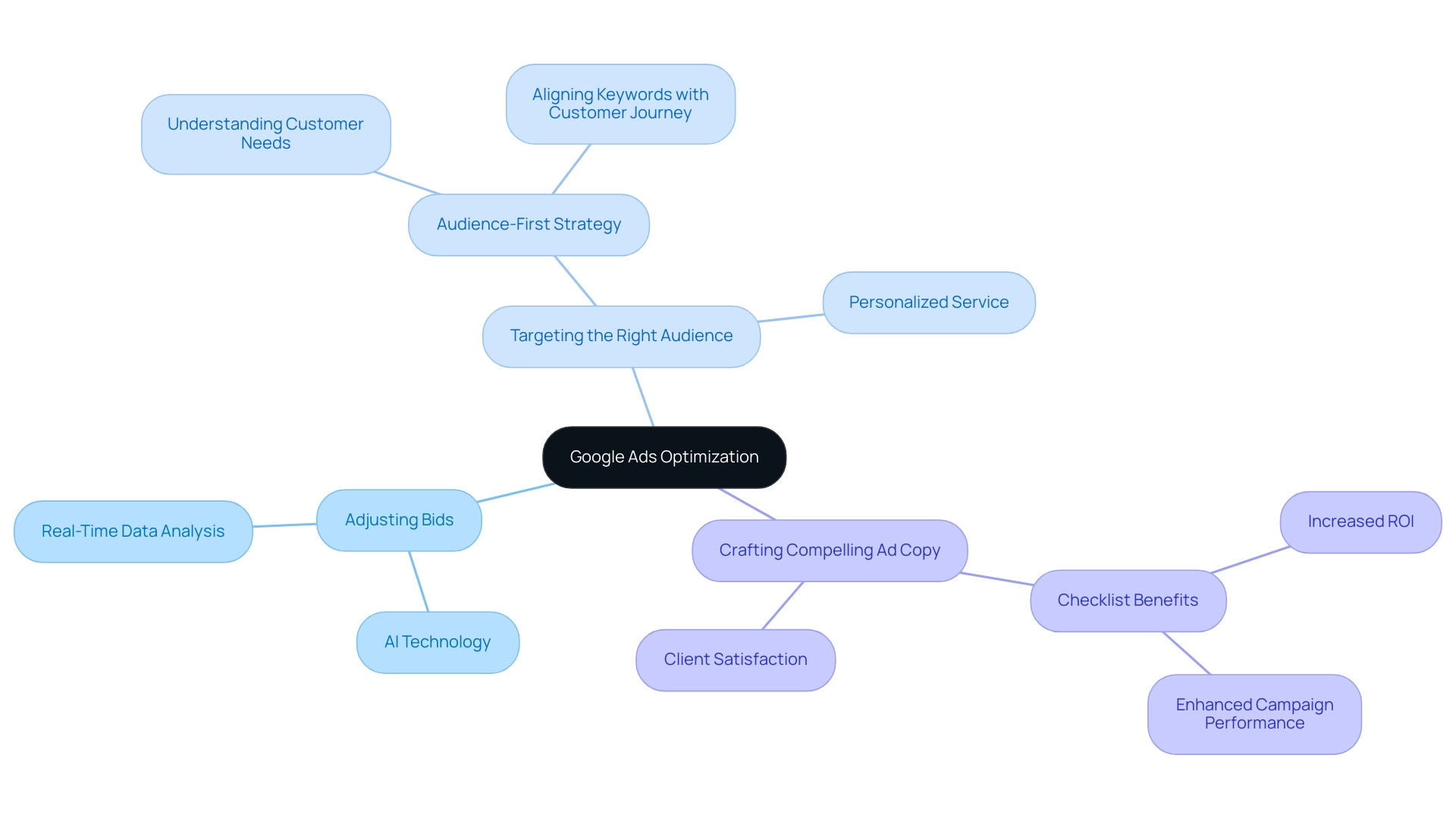
The Role of Keyword Research in Optimization
Effective keyword research is fundamental for identifying high-intent search terms that align with your business objectives. At DMKT Performance, we utilize advanced tools like Google Keyword Planner to uncover relevant keywords, assess their search volume, and evaluate competition levels. This process not only aids in identifying opportunities but also ensures that your advertising efforts are strategically aligned with market demand.
In 2025, the importance of keyword research has never been more pronounced, as businesses navigate an increasingly competitive digital landscape. Regularly updating your keyword list is essential to maintain the relevance and effectiveness of your ads. For instance, the surge in mental health-related searches, which rose by over 2,000% from April 2019 to March 2023, underscores the necessity for businesses to adjust their keyword strategies to reflect current trends and consumer interests.
This trend emphasizes the need to address relevant topics in your content strategies to capture the attention of potential customers.
Utilizing the latest keyword research tools can further enhance the effectiveness of your Google Ads optimization checklist. These tools provide insights into search volume for high-intent keywords, enabling you to craft campaigns that attract users actively seeking your products or services. Effective keyword strategies often involve a combination of broad and long-tail keywords, allowing for a comprehensive reach while targeting specific customer needs.
Notably, the combined organic traffic of the #2 to #5 spots is equivalent to the #1 spot, highlighting the necessity to target a range of keywords to maximize visibility.
Expert insights underscore the significance of a well-organized keyword plan. As Jyll Saskin-Gales, a digital marketing consultant, notes, “Effective keyword research not only drives traffic but also significantly impacts conversion rates.” By concentrating on high-intent keywords, businesses can leverage a Google Ads optimization checklist to enhance their ad campaigns for improved visibility and engagement, ultimately resulting in increased sales and growth.
Furthermore, with over 14 years of experience, DMKT Performance’s unique approach to online advertising emphasizes personalized service, operating on a one-client-per-industry basis. This ensures that clients receive tailored strategies that enhance their keyword research efforts, driving optimal ROI and business growth. To learn more about how we can assist your e-commerce business in thriving with Ads, contact DMKT Performance today!
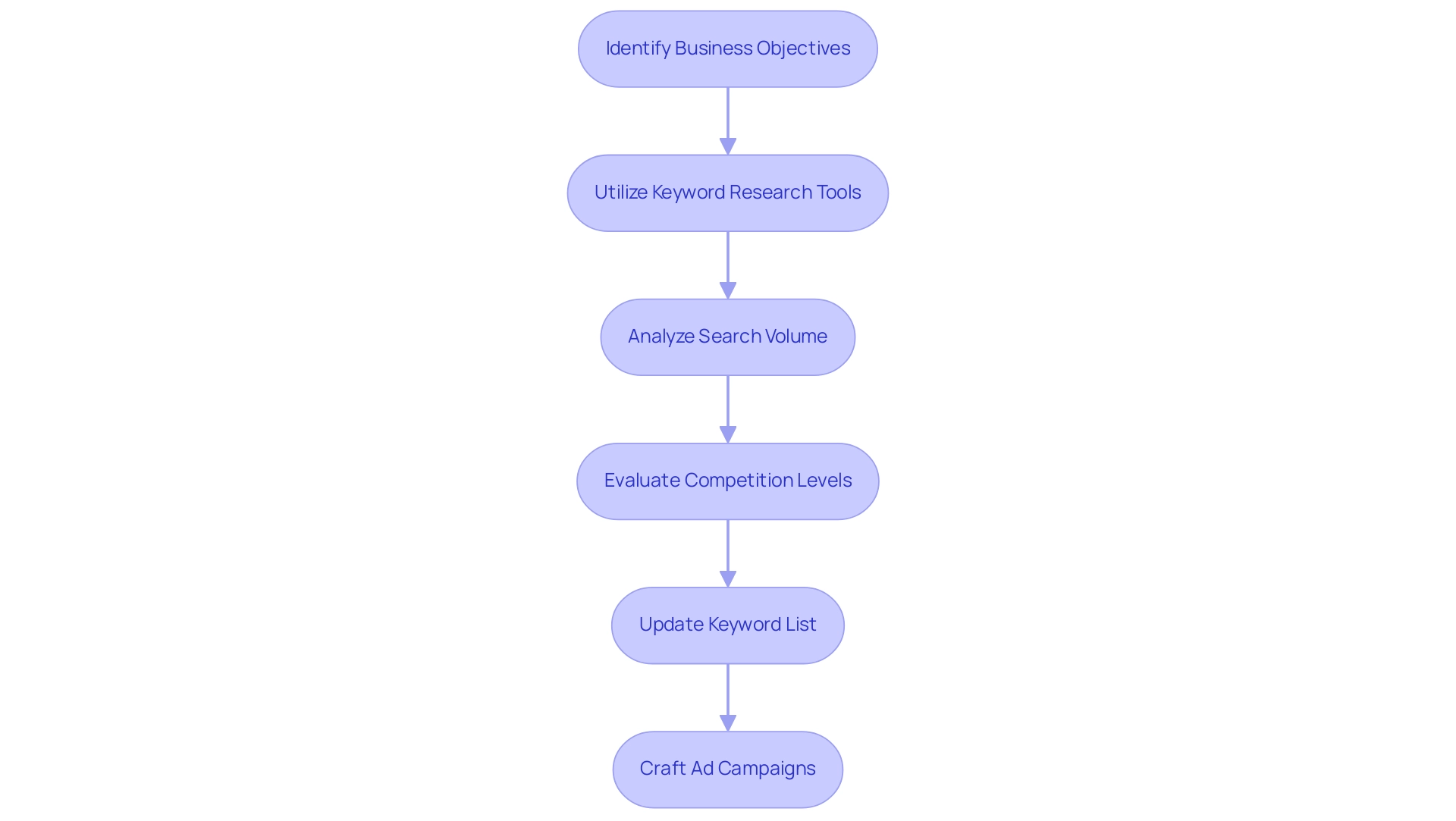
Crafting Compelling Ad Copy
Creating engaging ad text is a cornerstone of the Google Ads optimization checklist for successful ads optimization. It requires the use of clear and concise language that resonates with your target audience. Incorporating relevant keywords is essential for following a Google Ads optimization checklist, as they not only improve visibility but also align your message with what potential customers are actively searching for.
Highlighting unique selling points can differentiate your offerings in a crowded marketplace, making your ads more appealing.
Strong calls to action (CTAs) are crucial in driving user engagement and conversions. Effective CTAs prompt users to take immediate action, whether it’s making a purchase, signing up for a newsletter, or exploring your website further. For instance, phrases like “Shop Now” or “Get Your Free Trial Today” can significantly enhance click-through rates.
Testing different variations of ad copy is vital for identifying what resonates best with your audience, which should be included in your Google Ads optimization checklist. A recent analysis of 14,197 US-based WordStream client accounts, which collectively represented over $200 million in advertising expenditure, revealed that ads employing sentence case outperformed those in title case in terms of return on ad spend (ROAS) and click-through rates (CTR). This suggests that ads resembling organic content may connect better with users, emphasizing the importance of testing and adapting your approach.
As Andrea Cruz, Sr Director, Client Partner, noted, “Ad Strength is not a major metric, nor has it proven to be a reliable predictor of ad copy performance.” This insight underscores the need for e-commerce business owners to focus on crafting effective ad copy rather than relying solely on metrics like ad strength.
Furthermore, it’s crucial to take into account that while advertising expenses are increasing, DMKT Performance’s AI-driven approaches, especially those outlined in the Google Ads optimization checklist via Performance Max initiatives, can assist e-commerce businesses in reaching new customer segments and enhancing their advertisements for optimal effectiveness. Our intelligent algorithms analyze data and provide real-time performance insights, ensuring that your strategies are always fine-tuned for success. Statistics indicate that the average cost per acquisition (CPA) on the search network is currently lower than it was a couple of years ago, highlighting the potential for effective ad copy to yield better results even in a competitive landscape.
To craft compelling ad copy, consider these expert tips:
- Use clear language that communicates your message effectively.
- Focus on the benefits of your product or service rather than just features.
- Incorporate emotional triggers that resonate with your audience.
- Regularly review and refine your ad copy based on performance metrics.
By applying these approaches, e-commerce entrepreneurs can boost their Ads initiatives, attracting focused traffic and increasing conversion rates, while utilizing the knowledge of DMKT Performance to elevate their marketing efforts. Our tailored strategies and proven experience ensure that every dollar spent drives measurable results, helping you dominate your market.
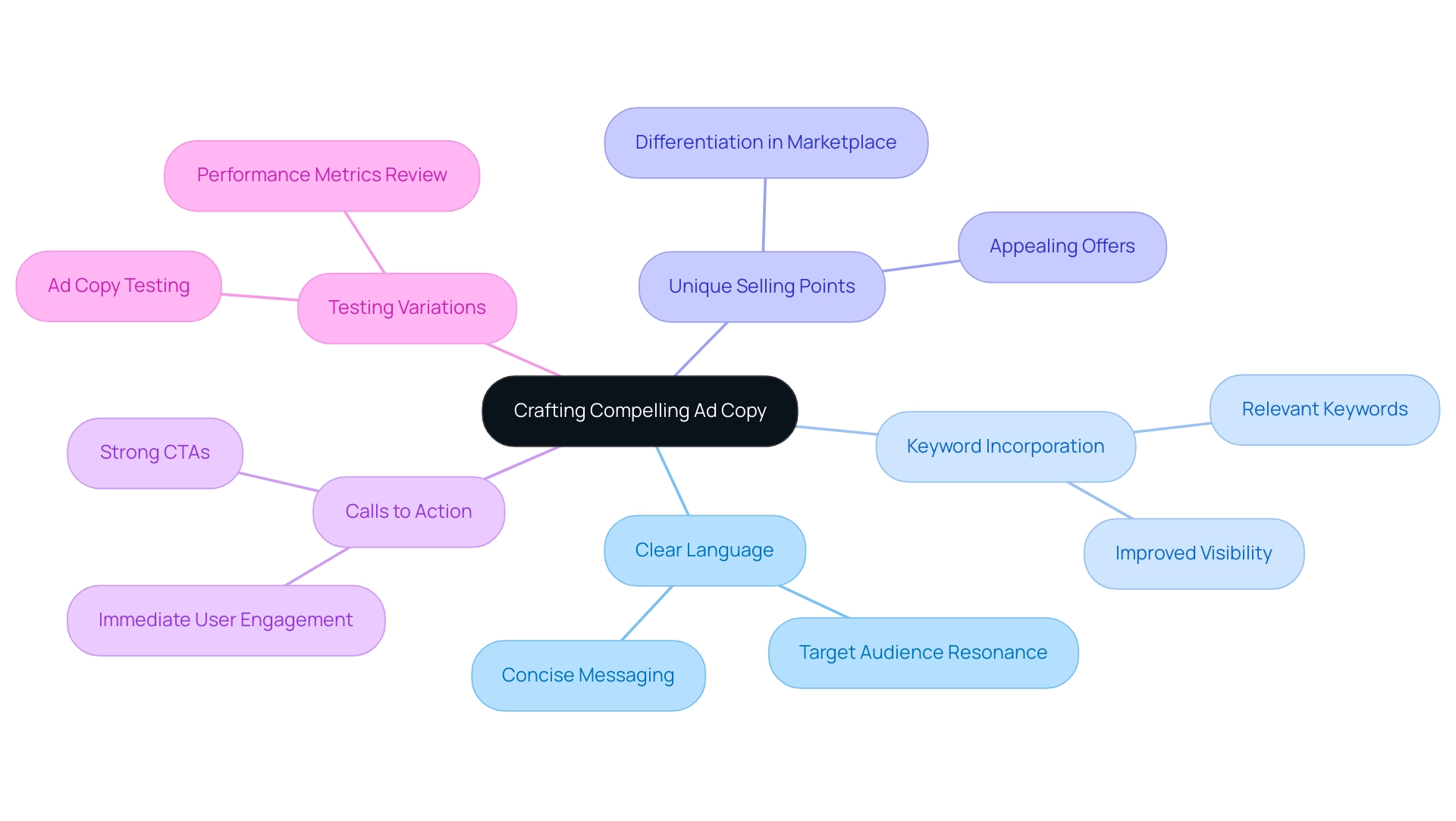
Effective Ad Group Structuring
Effective ad group organization is paramount for adhering to the Google Ads optimization checklist, particularly in the competitive landscape of 2025. By structuring ads around specific themes or products, advertisers can create tightly themed ad groups that feature relevant keywords and tailored ad copy. This focused approach not only enhances ad relevance but also significantly boosts Quality Score, a key determinant of ad placement and cost efficiency.
At DMKT Performance, we integrate a Google Ads optimization checklist into our comprehensive step-by-step process, starting with thorough account audits to pinpoint areas for improvement. By merging Performance Max and Shopping campaigns with our AI-driven methodologies, we elevate targeting and optimize ROI for our clients. Current best practices suggest limiting the number of ad groups to avoid prolonging the learning phase for bidding methods, especially when managing smaller budgets.
Utilizing an excessive number of ad groups can impede the learning process, making it crucial for advertisers to uphold a streamlined structure. A well-structured ad group can lead to enhanced performance metrics, allowing for more precise targeting and messaging. For instance, companies that embrace effective ad group organization often witness substantial improvements in their Quality Scores, which can result in decreased costs per click and heightened visibility in search results.
DMKT Performance exemplifies the benefits of this strategy through our commitment to personalized service and a one-client-per-industry model. This unique focus not only amplifies the effectiveness of initiatives but also cultivates long-term partnerships with clients, underscoring the value of a strategic approach to ad group organization. Our success stories, including collaborations with Nature’s Farmer Sea and STW, highlight how our tailored strategies have led to significant enhancements in digital presence and lead acquisition through Ads and SEO initiatives.
Expert insights further underscore the importance of this strategy. Susie Marino, Senior Content Marketing Specialist at WordStream, asserts that concentrating on fewer, more relevant ad groups enables advertisers to streamline their campaigns and achieve superior results. Successful case studies reveal that companies implementing these structuring techniques have experienced increased engagement and conversion rates, reinforcing the effectiveness of meticulous ad group organization.
In summary, best practices for structuring ad groups in online advertising can be effectively guided by a Google Ads optimization checklist that emphasizes focusing on specific themes, maintaining relevance in keywords and ad copy, and limiting the number of ad groups to optimize performance. This meticulous organization not only drives targeted traffic but also fosters long-term success in digital advertising. To enhance your e-commerce success and discover how DMKT Performance can assist you in increasing repeat sales and recovering abandoned carts, book a free consultation today!
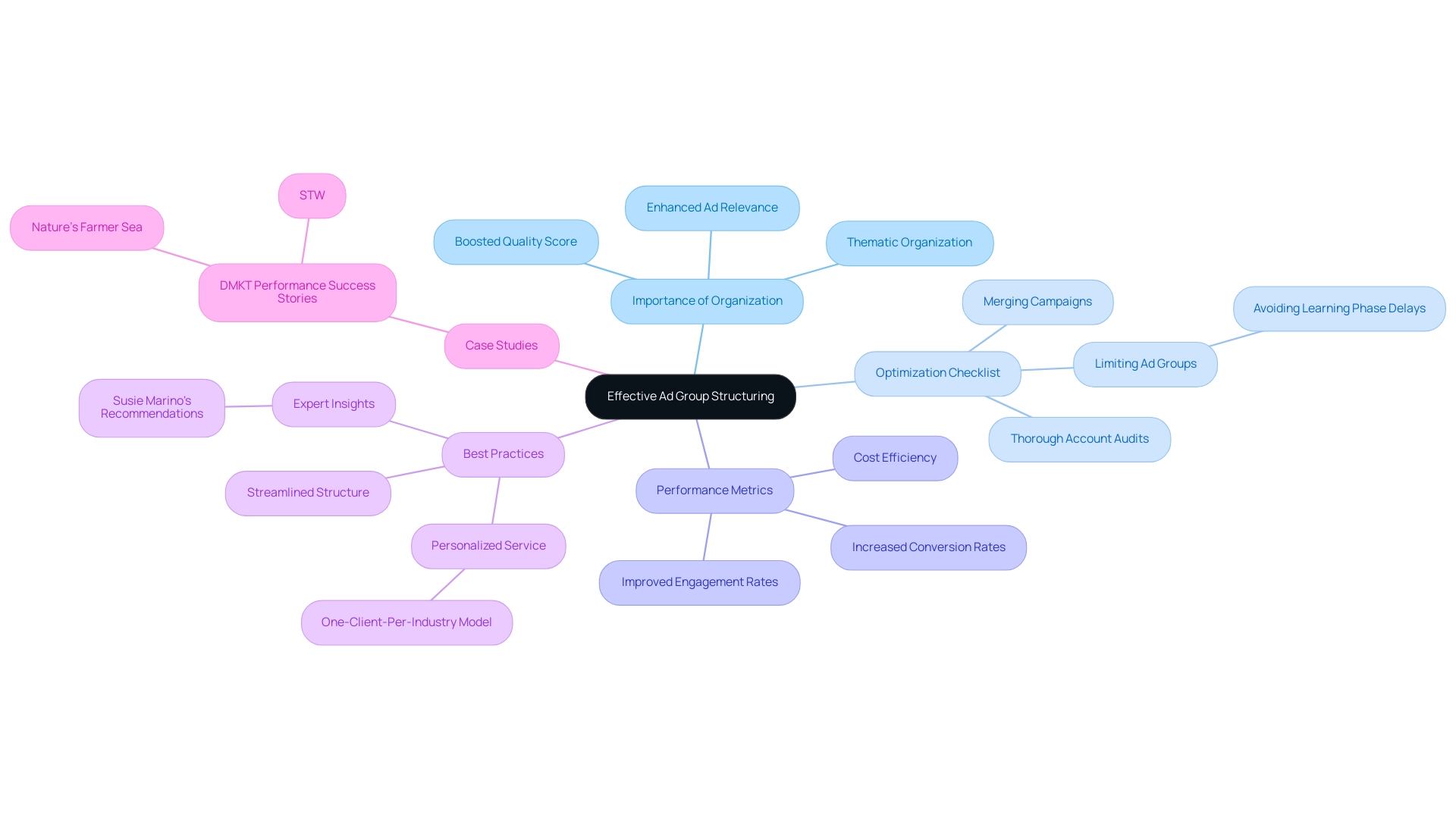
Leveraging Ad Extensions for Better Engagement
Ad extensions, including sitelinks, callouts, and structured snippets, are crucial for enhancing the effectiveness of your ads by providing users with additional information and options. By implementing a variety of ad extensions, advertisers can significantly boost their ads’ visibility and click-through rates. For instance, recent statistics indicate that ads utilizing extensions can achieve a click-through rate (CTR) increase of up to 30%.
This improvement is vital for e-commerce businesses striving to capture the attention of potential customers in a competitive landscape. Notably, Williams Sonoma achieved a remarkable 70% increase in mobile sales year-over-year by effectively utilizing ads, showcasing the potential impact of well-optimized campaigns.
To maximize the benefits of ad extensions, it is essential to regularly review and update them according to your Google Ads optimization checklist. This ensures that they reflect your current offerings and promotions, keeping your ads relevant while aligning them with user intent—an essential factor for driving engagement. A successful case study highlighting the impact of ad extensions comes from DMKT Performance, which implemented tailored PPC strategies for clients like Cooly Breeze Rooftop Restaurant.
By leveraging ad extensions effectively, they enhanced ad performance and improved cost-efficiency, ultimately maximizing ROI. In 2025, the advantages of using ad extensions are more pronounced than ever. They not only provide additional context to your ads but also enhance user experience by simplifying the process for potential customers to find the information they need. Expert insights suggest that utilizing ad extensions can lead to higher engagement rates, as they allow businesses to showcase unique selling points and direct users to specific landing pages.
Furthermore, compelling ad copy, adapting bidding methods, and managing location targeting are essential elements included in the Google Ads optimization checklist for optimizing advertising. Moreover, the latest features in advertising, such as automated extensions and enhanced sitelinks, further streamline the optimization process. These innovations enable advertisers to automatically generate extensions based on their website content, ensuring that ads remain dynamic and relevant.
As e-commerce continues to evolve, understanding the impact of ad extensions on click-through rates and overall performance will be crucial for businesses seeking to enhance their online presence and drive sales. Measuring return on investment (ROI) is also essential for Ads users, as it reflects the profitability of advertising efforts based on specific objectives. With DMKT Performance’s AI-driven strategies, including comprehensive management services that cover everything from keyword research to real-time optimization, e-commerce businesses can ensure their Ads efforts are not only effective but also positioned for sustained growth.
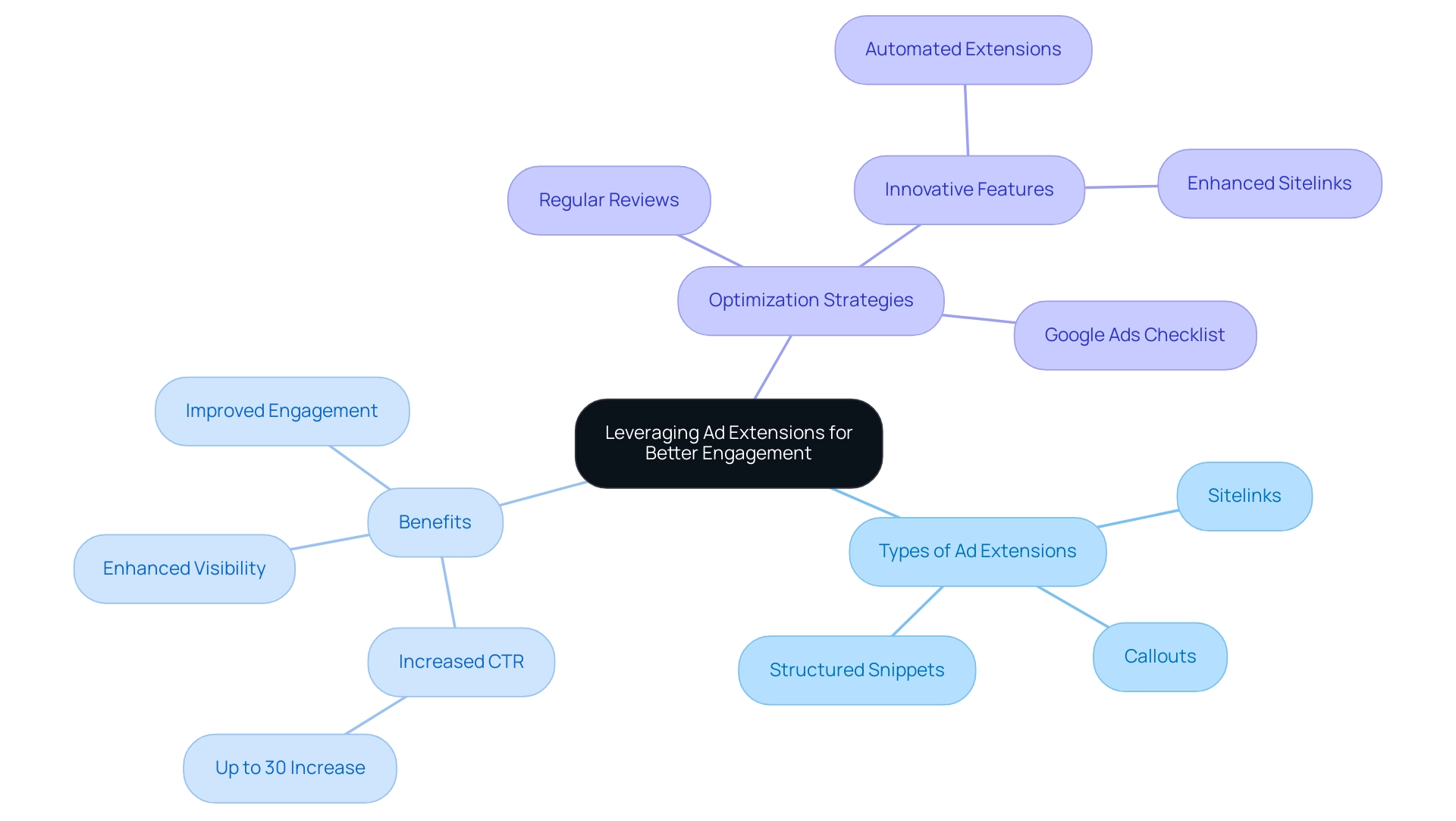
Regular Performance Analysis and Adjustments
To enhance the effectiveness of your advertising efforts, consistently evaluating performance is essential. Utilize the comprehensive reporting tools outlined in the Google Ads optimization checklist. Focus on key metrics such as Click-through Rate (CTR), conversion rates, and cost-per-click (CPC) included in your Google Ads optimization checklist. These metrics serve as vital indicators of your initiative’s engagement and efficiency.
Consider this: a higher CTR often correlates with effective ad copy and targeting, while conversion rates provide insights into how well your ads are driving desired actions.
At DMKT Performance, we employ a step-by-step process for optimizing Google Ads efforts, beginning with comprehensive account audits to identify areas for improvement. We merge Performance Max and Shopping initiatives with our AI-driven approaches to enhance your effectiveness. By utilizing advanced data analysis, we refine targeting strategies and ad copy to ensure alignment with your overarching business objectives.
Continuous monitoring is crucial; it enables you to identify trends and make timely modifications that can enhance performance and reduce wasted ad spend, as outlined in a Google Ads optimization checklist.
Looking ahead to 2025, understanding and leveraging these key metrics will be more important than ever. As the digital advertising landscape evolves, staying attuned to performance analysis will empower you to navigate challenges and seize opportunities for growth. Successful case studies, such as our partnership with Nature’s Farmer Sea and STW, illustrate how utilizing a Google Ads optimization checklist to examine conversion metrics is vital for obtaining insights into the effectiveness and influence of advertising strategies.
Marketers can leverage a Google Ads optimization checklist to monitor CTR and other conversion metrics, helping to identify trends, optimize ad relevance, and improve targeting strategies. This leads to better performance and reduced wasted ad spend.
Moreover, Improvado allows marketers to assess the actual effect of Ads initiatives within the broader framework of their marketing ecosystem, ensuring more precise attribution. As Jack Shepherd, Co-Founder & Marketing Director, highlights, “65% of small-to-midsize businesses are managing their own PPC efforts, assisting them in acquiring new customers.” This statistic underscores the relevance of performance analysis for e-commerce business owners.
For those new to Ads, it is advisable to start learning key metrics and utilize a Google Ads optimization checklist alongside preset Ads report templates to help track these KPIs effectively. This practical method will not only enhance your understanding but also empower you to make data-driven decisions that can significantly improve your results. To further refine your Ads approach, schedule a complimentary consultation with DMKT Performance today!
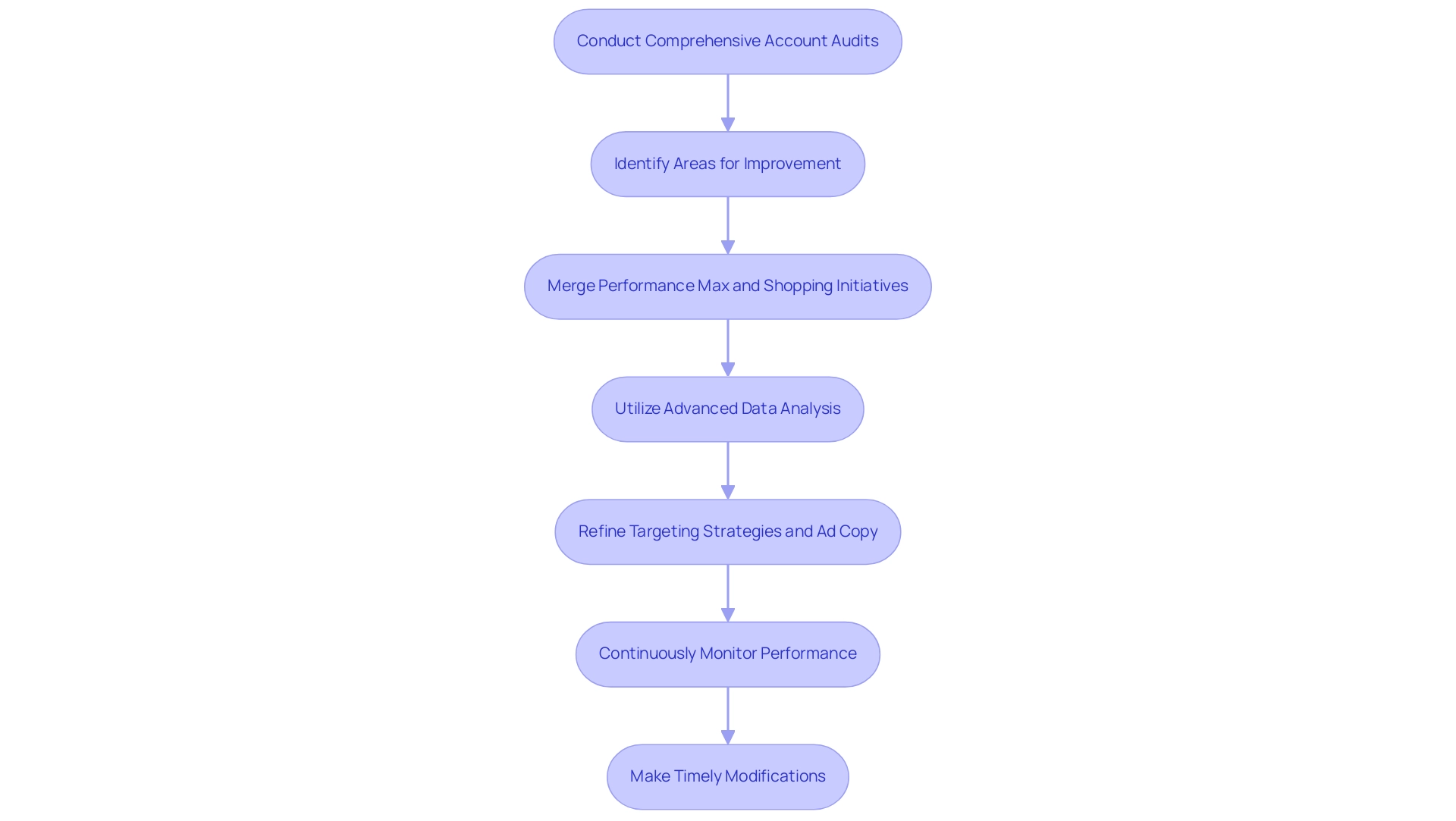
Strategic Bid Management Techniques
To optimize your ad spend effectively, implementing strategic bid management techniques is crucial. Automated bidding methods, such as Target CPA and Maximize Conversions, leverage advanced machine learning capabilities to enhance performance. These approaches facilitate real-time adjustments based on user behavior and market dynamics, ensuring your ads reach the right audience at the right moment.
At DMKT Performance, we harness advanced AI technology and intelligent algorithms to optimize your Ads initiatives, including Shopping and Performance Max, for maximum ROI. Our comprehensive management services cover every aspect of your Google Ads strategy, guided by the Google Ads optimization checklist. This includes keyword research, ad creation, optimization, and reporting. Regular performance reviews of your bidding strategies are essential.
By analyzing key metrics and aligning your strategies with objectives and prevailing market conditions, you can maximize your return on investment. For example, recent statistics reveal that the overall cost per lead (CPL) increased by $13.17 from the previous year, underscoring ongoing challenges for advertisers in managing costs amid rising advertising expenses. However, many advertisers employing automated bidding have reported a decrease in CPL, showcasing the potential for improved cost efficiency.
Expert insights indicate that the true measure of an advertisement lies in its ability to drive business results. As Michelle Morgan, Co-Founder of Paid Media Pros, aptly states, ‘But the real test of an ad effort is how much business it actually drives.’ The effectiveness of automated bidding methods is evident in their capacity to adapt to changing market conditions, ultimately leading to improved conversion rates.
Case studies, including our collaboration with STW, demonstrate that businesses utilizing strategic bid management techniques have successfully navigated the complexities of digital advertising, transforming challenges into opportunities for growth.
In 2025, staying informed about the latest bid management techniques is vital. Resources are available to help you understand Smart Bidding and best practices for enhancing your Ads strategies, including the Google Ads optimization checklist. By leveraging these insights and continuously refining your approach, you can ensure that your advertising efforts yield optimal outcomes.
DMKT Performance, focusing exclusively on Ads and employing a one-client-per-industry strategy, exemplifies the expertise required to excel in bid management techniques. Our services also encompass Search Ads and YouTube Ads, ensuring a comprehensive approach to your advertising needs.
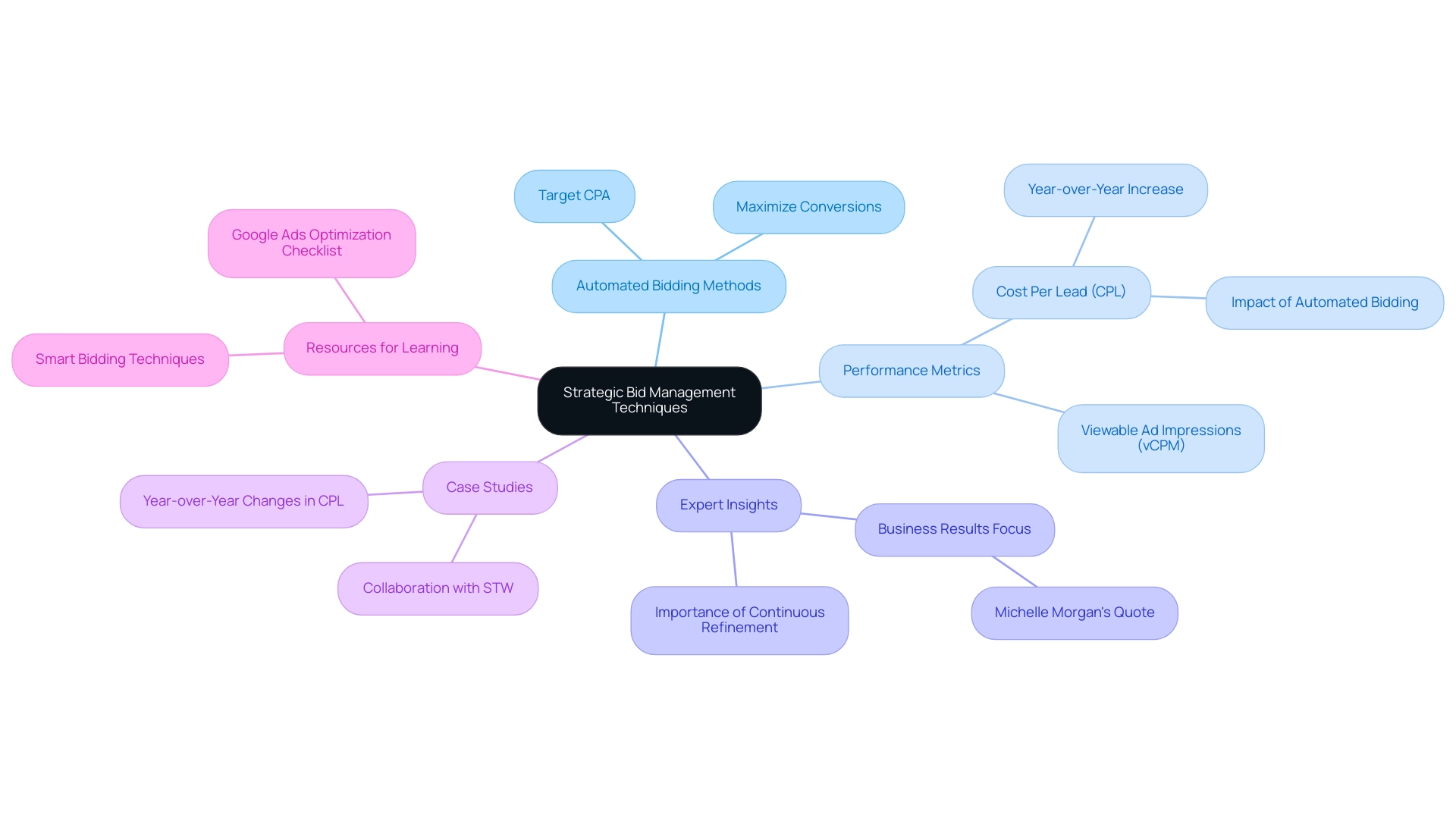
Optimizing Landing Pages for Higher Conversions
To maximize conversions from your Ads campaigns, it is crucial to ensure that your landing pages are meticulously optimized. Start by aligning the content of your landing pages with your ad messaging. This alignment creates a seamless experience for users, reinforcing their decision to click through.
Use clear, compelling headlines, concise copy, and strong calls-to-action (CTAs) to guide visitors toward taking the desired action. Page load speed plays a pivotal role in conversion rates; studies show that even a one-second delay can lead to a 7% reduction in conversions. Therefore, optimizing your landing pages for speed and ensuring mobile responsiveness are essential best practices. In 2025, it is more crucial than ever to develop a user-friendly experience that accommodates the growing number of mobile users.
Implementing A/B testing is another effective approach for optimizing landing pages. This method allows you to experiment with different designs and elements, helping you identify which variations yield the highest conversion rates. For instance, a recent case study of Cooly Breeze Rooftop Restaurant, conducted by DMKT Performance, demonstrated that businesses utilizing A/B testing saw significant improvements in their landing page performance, leading to data-driven results that enhanced overall effectiveness.
Moreover, consider the importance of lead magnets; statistics indicate that 55% of landing page submissions come from these incentives. By asking for less sensitive information, such as just an email and phone number, you can improve conversion rates, following the Breadcrumb Technique for lead collection. This approach not only simplifies the process for users but also increases the likelihood of capturing leads.
Understanding industry benchmarks for conversion rates is also crucial for evaluating landing page performance and setting realistic goals. As noted by Unbounce, the correlation between effective landing page design and conversion rates has significantly increased from -15% in 2020 to 24.3% today, reflecting a 62% improvement. This highlights the significance of consistently improving your landing page strategies.
In summary, the process of optimizing landing pages for advertisement conversions can be guided by a Google Ads optimization checklist that includes:
- Aligning content with ad messaging
- Enhancing page load speed
- Ensuring mobile responsiveness
- Leveraging A/B testing
By adopting these strategies, as evidenced by the success of Cooly Breeze Rooftop Restaurant through DMKT Performance, you can significantly improve your conversion rates and drive more successful outcomes from your digital marketing efforts.
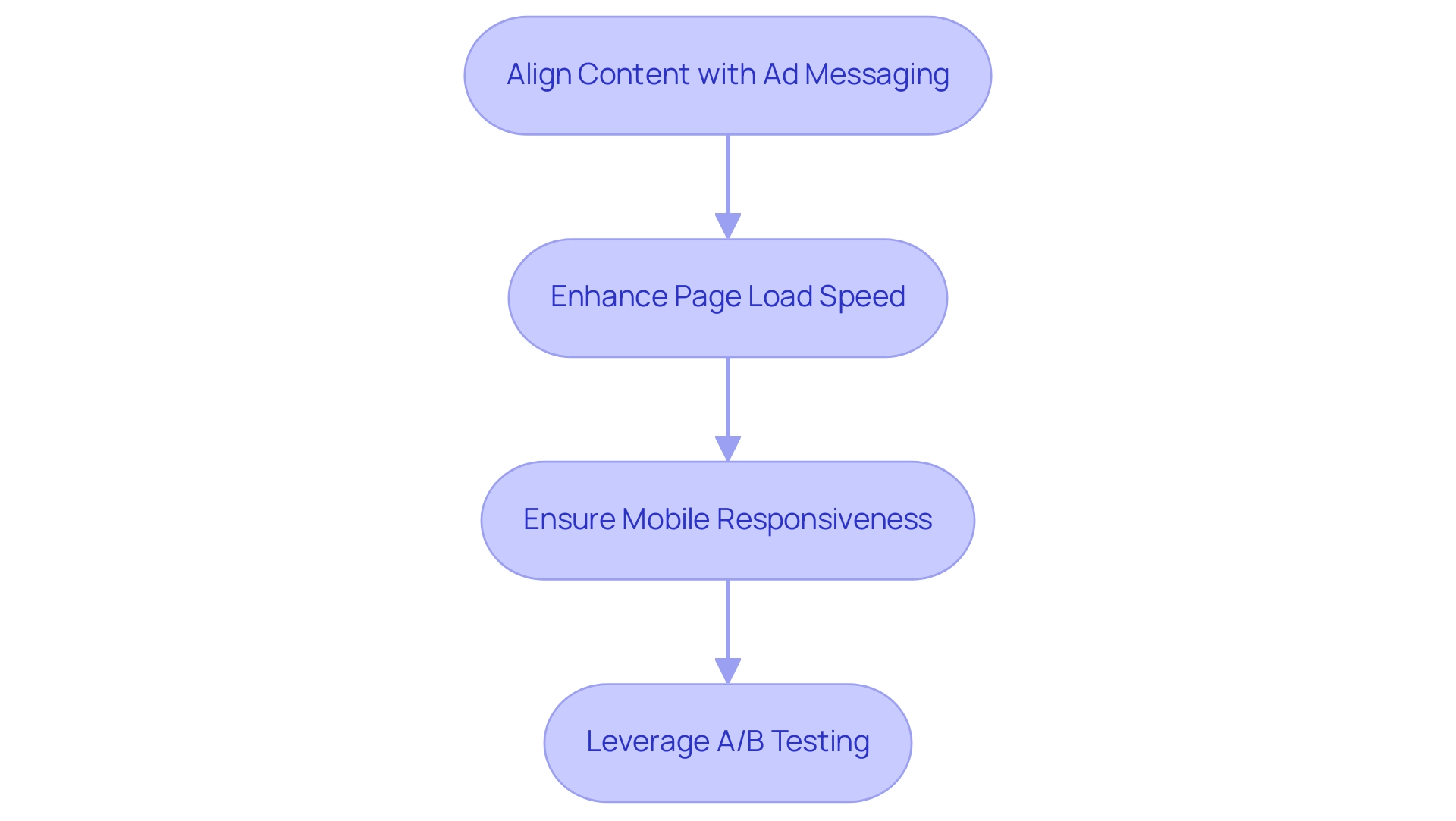
Utilizing Negative Keywords Effectively
Incorporating negative keywords into your Google Ads strategies is essential for preventing your ads from appearing in irrelevant searches. This strategic approach not only enhances ad relevance but also significantly reduces wasted ad spend, ultimately improving overall performance. At DMKT Performance, we emphasize the importance of regularly reviewing search term reports to identify potential negative keywords that should be excluded from your strategies.
By doing so, you can refine your targeting and ensure that your ads reach the most relevant audience.
Effective management of negative keywords is crucial in 2025, as the landscape of online advertising continues to evolve. Statistics indicate that a substantial portion of ad spend is wasted due to irrelevant searches, underscoring the need for meticulous keyword management. For instance, our case studies, including the success of Nature’s Farmer Sea and Cooly Breeze Rooftop Restaurant, highlight the importance of understanding your target audience and their search behaviors.
Utilizing tools like Google Keyword Planner can aid in identifying irrelevant terms that should be excluded, ensuring your campaigns remain effective over time.
Expert opinions emphasize that negative keywords are not merely an afterthought but a fundamental element of a successful PPC approach. Shane Cousins, a recognized PPC expert, states, “If you’re aiming to enhance your PPC approach, don’t disregard the significance of negative keywords.” This sentiment reflects a growing recognition of how negative keywords can enhance ad relevance and drive better results.
Moreover, Performance Max initiatives at DMKT Performance utilize AI technology to optimize advertising across all channels, further illustrating the significance of effective keyword management in enhancing initiative performance. By implementing a robust negative keyword strategy, you can transform potential pitfalls into opportunities for increased visibility and conversion rates. Successful instances from different initiatives demonstrate that companies prioritizing negative keyword management witness a significant enhancement in their advertisement performance, highlighting its importance in the Google Ads optimization checklist.
At DMKT Performance, we provide comprehensive campaign management services that cover every aspect of your Ads campaigns, from keyword research and ad creation to optimization and reporting. Our tailored strategies are designed to align with your business goals, ensuring maximum ROI through data-driven optimization processes.
Stay tuned for the next installment of the Ads series, which will explore the nuances of Ads and Merchant Center. By concentrating on effective negative keyword management, you can maximize your ad spend efficiency and ensure your efforts are always aligned with your business goals. Schedule a Free Consultation with DMKT Performance today to enhance your Ads approach!
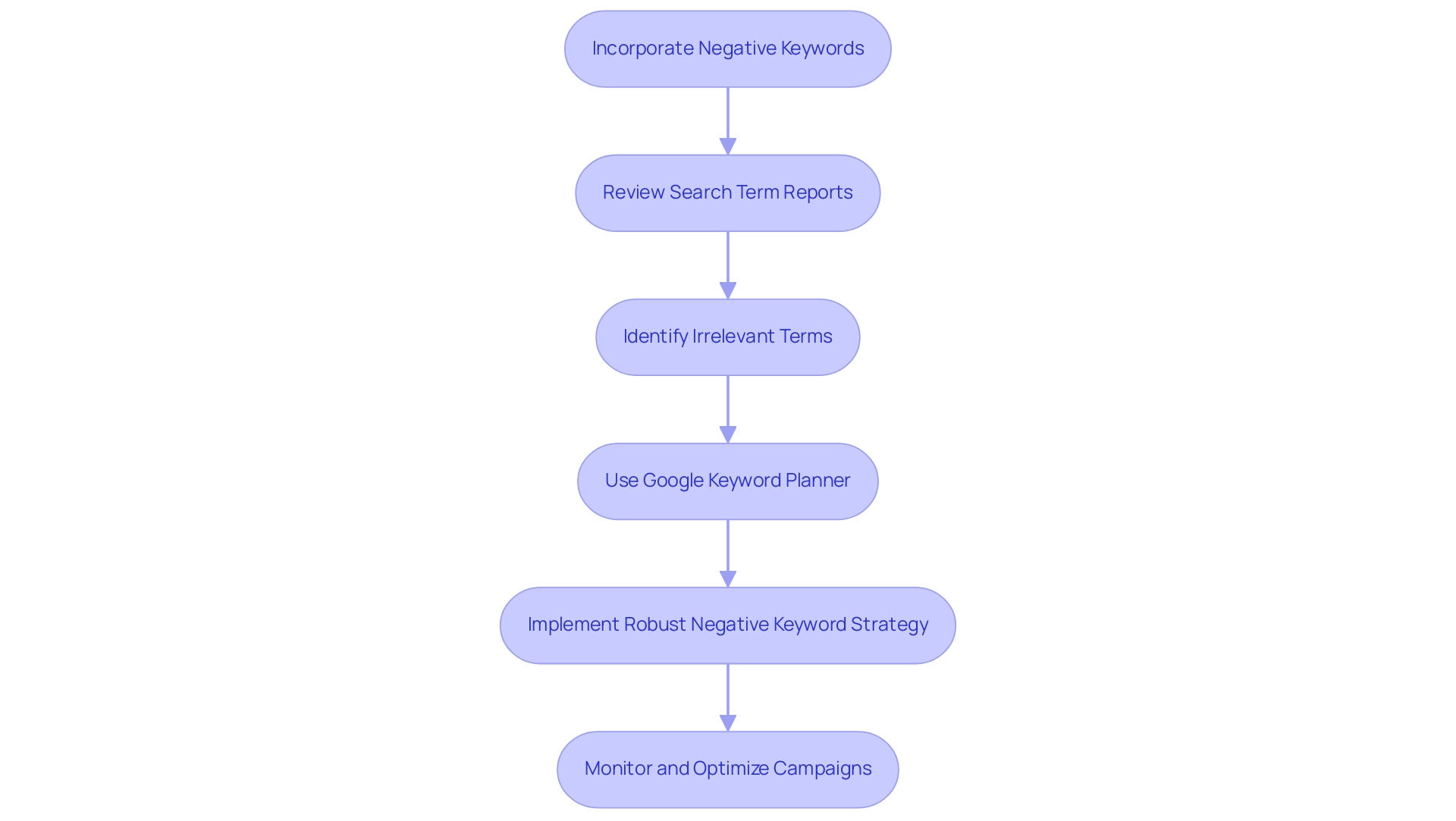
The Importance of Continuous Testing and Iteration
Foster a culture of ongoing testing and iteration within your advertising efforts by leveraging a Google Ads optimization checklist to maximize effectiveness. At DMKT Performance, we underscore the critical importance of regularly experimenting with diverse ad copies, landing pages, and bidding strategies to identify the most successful components. A/B testing serves as a powerful tool in this endeavor, enabling you to compare different variations and make informed, data-driven decisions that significantly enhance performance.
In 2024, the average click-through rate (CTR) for Google Ads reached 6.42%, underscoring the necessity of adapting strategies to maintain visibility in an increasingly competitive landscape. This figure represents a median value, accounting for outliers across various industries, which highlights the need for customized strategies in your efforts. Ongoing testing helps pinpoint the most effective advertisements while ensuring that your Google Ads optimization checklist keeps your strategies flexible and adaptable to market changes.
Digital marketing specialists, including Praveen Johny, emphasize that even minor increases in market research input can lead to exponential enhancements in success. By implementing A/B testing, you can systematically refine your approach, ensuring that your ads resonate with your target audience. Successful instances of A/B testing in PPC campaigns, such as those observed in our case studies with Nature’s Farmer Sea and STW, illustrate how iterative adjustments can yield substantial increases in engagement and conversion rates.
As you navigate the complexities of Google Ads in 2025, remember that adhering to a Google Ads optimization checklist for continuous testing and optimization is essential for sustained growth and success in the digital marketplace. Insights from our case studies further demonstrate how continuous testing can enhance performance, making it imperative for advertisers to adapt their strategies accordingly.

Conclusion
Mastering Google Ads optimization is not just advantageous; it is essential for businesses aiming to elevate their online visibility and drive conversions. This article has delved into key strategies that are pivotal to your success, including:
- Effective keyword research
- Crafting compelling ad copy
- Implementing structured ad group organization
Each of these elements is integral in ensuring that your campaigns resonate with your target audience and yield the desired results.
Furthermore, leveraging tools such as:
- Ad extensions
- Negative keywords
can significantly enhance engagement while minimizing wasted spend. The focus on continuous performance analysis and strategic bid management techniques underscores the necessity of adapting to the ever-evolving digital landscape. By prioritizing these strategies, your business can not only improve the effectiveness of its Google Ads campaigns but also cultivate long-term partnerships with agencies that comprehend your unique needs.
Ultimately, a steadfast commitment to data-driven decision-making and ongoing testing will empower your business to navigate the complexities of digital advertising with confidence. As the landscape continues to shift, embracing these optimization techniques is crucial for maintaining a competitive edge and fostering sustainable growth. The time to elevate your Google Ads performance is now; with the right strategies in place, you can transform clicks into loyal customers.
Frequently Asked Questions
What is the purpose of a Google Ads optimization checklist?
The Google Ads optimization checklist is designed to enhance ads by refining various elements, improving performance, and achieving superior results through strategies such as adjusting bids, targeting the right audience, and crafting compelling ad copy.
How does DMKT Performance utilize technology in Google Ads optimization?
DMKT Performance uses advanced AI technology and intelligent algorithms to create and optimize Google Shopping and Performance Max strategies, which consistently outperform the competition.
Why is understanding customer behavior important in ad optimization?
Understanding customer behavior allows marketers to transition from a keyword-centric approach to an audience-first strategy, enhancing relevance and ensuring that ads resonate with potential buyers.
Can you provide an example of a successful strategy implemented by DMKT Performance?
A case study from DMKT Performance showed that by implementing an audience-first strategy, they enhanced performance and client satisfaction, resulting in increased engagement metrics and conversion rates.
What are the benefits of employing a Google Ads optimization checklist?
Utilizing a Google Ads optimization checklist can lead to significant ROI, increased visibility, improved web traffic, and higher conversion rates for businesses.
What role does keyword research play in Google Ads optimization?
Effective keyword research identifies high-intent search terms that align with business objectives, ensuring advertising efforts are strategically aligned with market demand.
How has the importance of keyword research changed in recent years?
The importance of keyword research has increased as businesses face a competitive digital landscape, necessitating regular updates to keyword lists to maintain relevance and effectiveness.
What strategies should be employed for effective keyword targeting?
Effective keyword strategies should involve a combination of broad and long-tail keywords to maximize visibility while targeting specific customer needs.
How can businesses create engaging ad text?
Engaging ad text should use clear and concise language, incorporate relevant keywords, highlight unique selling points, and include strong calls to action to drive user engagement and conversions.
What insights do experts provide regarding ad copy performance?
Experts emphasize the need for crafting effective ad copy rather than relying solely on metrics like ad strength, highlighting that ads resembling organic content may connect better with users.
How can DMKT Performance assist businesses in their advertising efforts?
DMKT Performance provides tailored strategies and utilizes AI-driven approaches to refine targeting and bidding, ensuring that every dollar spent on ads drives measurable results.
